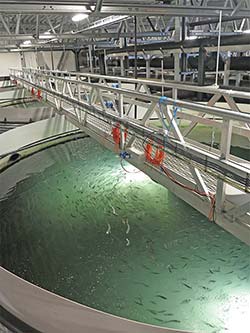AquaBounty Technologies, a Maynard, Massachusetts-based aquaculture biotech company that is a majority-owned subsidiary of Intrexon Corporation, announced on October 16 that its Canadian subsidiary has received a construction loan in the amount of CA $2.0 million (US $1.6 million) from the Department of Economic Development of the Province of Prince Edward Island (PEI). The cash will be used to complete construction of a 250-metric ton production facility at its Rollo Bay site.
The PEI project, which includes an R&D hatchery, is currently undergoing construction of a 250-metric ton production facility and a broodstock facility. Once complete, 20 to 30 technical jobs are expected to be added to AquaBounty’s operation.
“This loan should enable us to complete construction of the grow-out facility at Rollo Bay by the end of this year and to commence commercial production of our innovative AquAdvantage Salmon in early 2019,” said CEO Ronald Stotish. “The facility will demonstrate the superior economics that AquAdvantage brings to land-based recirculating aquaculture systems. We are very grateful for the support we have received and continue to receive from the Province of Prince Edward Island.”
AquAdvantage Salmon is an Atlantic salmon that has been bioengineered to grow to market size in about half the time of a traditional farmed Atlantic salmon. According to Stotish, it significantly improves the economics of producing salmon in land-based contained facilities and is a healthy, environmentally sustainable alternative to imported farmed Atlantic salmon.
Newfoundland Roots
The origin of AquaBounty’s technology dates back to1989, when Dr. Garth Fletcher and his research team at Memorial University of Newfoundland, Canada, discovered that a novel application of molecular genetics could significantly increase the growth of Atlantic salmon. By integrating a Chinook growth hormone gene into the genome of an Atlantic salmon, they discovered that they could reduce the time to market from three years to 18 months.
 The second innovation in sustainable fish farming production came with the development of land-based recirculating aquaculture systems, or RAS for short. While farming salmon in sea cages is less expensive and less technologically complex than a land-based farm, land-based salmon farming eliminates many of the environmental problems associated with net-pen farms. Sea cages are susceptible to a number of hazards such as violent storms, predators, harmful algal blooms, jellyfish attacks, fish escapes, and the transmission of pathogens and parasites from wild fish populations residing near the cages. All of these hazards can cause significant fish losses over the course of the 28-36-month production cycle.
The second innovation in sustainable fish farming production came with the development of land-based recirculating aquaculture systems, or RAS for short. While farming salmon in sea cages is less expensive and less technologically complex than a land-based farm, land-based salmon farming eliminates many of the environmental problems associated with net-pen farms. Sea cages are susceptible to a number of hazards such as violent storms, predators, harmful algal blooms, jellyfish attacks, fish escapes, and the transmission of pathogens and parasites from wild fish populations residing near the cages. All of these hazards can cause significant fish losses over the course of the 28-36-month production cycle.
Some fish farmers, research scientists and engineers studied the technology used in public aquariums and human waste-water treatment facilities with the idea that the technology could be applied to large-scale commercial seafood production on land. Over the last 30 years, the technology to farm fish on land has dramatically progressed so much so that fish farmers are developing large RAS facilities to grow a variety of species, from salmon, trout and sturgeon to perch, shrimp and even lobster.
The first commercial application of RAS technology in salmon farming was the development of land-based RAS systems designed to produce juvenile salmon (smolts), which were traditionally reared in cages in lakes. These early RAS systems would rear smolts on land for about a year to a size suitable for stocking in sea cages, where they would be grown for another two years to market size. The reason that salmon farmers did not grow-out their salmon to market size in the RAS facilities was the cost.
AquaBounty’s innovative AquAdvantage Salmon, with its fast growth rate, shortens the production cycle from 28-36 months to 16-18 months, transforming land-based salmon farming into an economically viable production model.
Land-based salmon farming confines the fish to indoors tanks inside facilities resembling warehouses, eliminating interactions between the farmed fish and the external environment. According to Stotish, “The only things emerging from the building are harvested salmon on their way to the processing plant, a trickle of waste-water that can be used by vegetable farmers and greenhouse growers, and solids filtered out of the recycled water that can be used for fertilizer by gardeners.”





